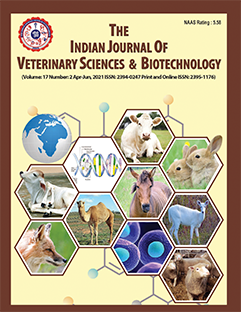Management of Bee Sting Induced Anaphylaxis and Acute Kidney Injury in a Husky Dog
DOI:
https://doi.org/10.48165/ijvsbt.21.5.39Keywords:
Apidae (bees), Formicidae, erythrocytes, leukocytesAbstract
Apidae (bees), Vespidae (hornets, wasps, and yellow jackets), and Formicidae (fire ants) the three genera of Hymenoptera are most responsible for physical symptoms associated with allergic reactions seen in veterinary facilities (Casale and Burks, 2014). The venom in the sting can produce conditions ranging from minor local lesions to life threatening systemic reactions. It is worth mentioning here that the honeybees can only sting once in their lifetime as their barbed stinger snags in the victim’s skin, ripping the stinging mechanism from the bee’s body and killing the bee. The venom sac keeps contracting outside the body of the bee, and 100% of its venom is delivered over 60 seconds. Honeybee venom is a clear acidic substance consisting of several enzymes, proteins, and amines that can cause poisonous and adverse reactions in the bodies of those who are exposed to it. Melittin and phospholipase A2 are the primary components of bee venom, however several additional chemicals are also present. These compounds cause haemolysis, rhabdomyolysis, renal tubule degradation, and necrosis, ultimately leading to failure of the organs (Almeida et al., 2011). Melittin, in collaboration with phospholipase A2, breaks cell membranes in certain mammals, resulting in lysis of erythrocytes, leukocytes, platelets, myocytes, and vascular endothelium. Hyaluronidase, often known as “spreading factor” in venom, is responsible for modifying the permeability of cell membranes and thus allowing other venom components to permeate into the tissues of the host. Melittin has the potential to adhere to and generate transitory holes on the surface of red blood cells, which can range from minor to severe depending on weather conditions, age, and the types of flowers used by bees for honey production. The deadly dose for humans and mammals is believed to be 500 stings per adult and 20 stings per kilogram, respectively (Vetter et al., 1999). Intravascular haemolysis, rhabdomyolysis, hepatopathy, cardiac injury, acute kidney injury, immune mediated haemolytic anaemia (IMHA), immune-mediated thrombocytopenia (IMTP), and disseminative intravascular coagulopathy (DIC) are all side consequences of severe envenomation and anaphylaxis. This document reports successful management of bee sting induced anaphylaxis and acute kidney injury in a Husky dog.
Downloads
References
Almeida, R.A., Olivo, T.E., Mendes, R.P., Barraviera, S.R., Souza, L.R., Martins, J.G., Hashimoto, M., Fabris, V.E., Ferreira Junior, R.S., & Barraviera, B. (2011). Africanized honey bee stings: How to treat them. Revista da Sociedade Brasileira de Medicina Tropical, 44(6), 755–761.
Buckley, G.J., Corrie, C., Bandt, C., & Schaer, M. (2017). Kidney injury in a dog following bee sting-associated anaphylaxis. The Canadian Veterinary Journal, 58(3), 265.
Casale, T.B., & Burks, A.W. (2014). Hymenoptera-sting hypersensitivity. New England Journal of Medicine, 370(15), 1432–1439.
Nair, R., Riddle, E.A., & Thrall, M.A. (2019). Haemolytic anaemia, spherocytosis, and thrombocytopenia associated with honey bee envenomation in a dog. Veterinary Clinical Pathology, 48(4), 620–623.
Nakamura, R.K., Fenty, R.K., & Bianco, D. (2013). Presumptive immune-mediated thrombocytopenia secondary to massive Africanized bee envenomation in a dog. Journal of Veterinary Emergency and Critical Care, 23, 652–656.
Pucca, M.B., Cerni, F.A., Oliveira, I.S., Jenkins, T.P., Argemí, L., Sørensen, C.V., Ahmadi, S., Barbosa, J.E., & Laustsen, A.H. (2019). Bee updated: Current knowledge on bee venom and bee envenoming therapy. Frontiers in Immunology, 6(10), 2090.
Silva, F.L.A., Botelho, A.F.M., Wagatsuma, M.M., Paiva, H.P., Bicalho, A.L.F., & Meloet, M.M. (2022). Toxic systemic reaction after bee stings in a bitch. Acta Scientiae Veterinariae, 50(Suppl 1), 791.
Vetter, R.S., Visscher, P.K., & Camazine, S. (1999). Mass envenomations by honey bees and wasps. Western Journal of Medicine, 170(4), 223.
Downloads
Published
Issue
Section
License
Copyright (c) 2025 Indian Journal of Veterinary Sciences and Biotechnology

This work is licensed under a Creative Commons Attribution-NonCommercial-NoDerivatives 4.0 International License.




